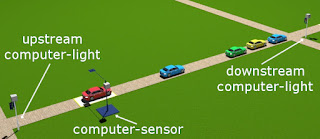Paper published: Deliberative Self-Organizing Traffic Lights with Elementary Cellular Automata
Self-organizing traffic lights have shown considerable improvements compared to traditional methods in computer simulations. Self-organizing methods, however, use sophisticated sensors, increasing their cost and limiting their deployment. We propose a novel approach using simple sensors to achieve self-organizing traffic light coordination. The proposed approach involves placing a computer and a presence sensor at the beginning of each block; each such sensor detects a single vehicle. Each computer builds a virtual environment simulating vehicle movement to predict arrivals and departures at the downstream intersection. At each intersection, a computer receives information across a data network from the computers of the neighboring blocks and runs a self-organizing method to control traffic lights. Our simulations showed a superior performance for our approach compared with a traditional method (a green wave) and a similar performance (close to optimal) compared with a self-organizing method using sophisticated sensors but at a lower cost. Moreover, the developed sensing approach exhibited greater robustness against sensor failures.
Zapotecatl, J. L., Rosenblueth, D. A., and Gershenson, C. (2017). Deliberative self-organizing traffic lights with elementary cellular automata. Complexity, 2017:7691370. https://doi.org/10.1155/2017/7691370
Zapotecatl, J. L., Rosenblueth, D. A., and Gershenson, C. (2017). Deliberative self-organizing traffic lights with elementary cellular automata. Complexity, 2017:7691370. https://doi.org/10.1155/2017/7691370

Comments